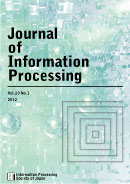20 巻, 4 号
選択された号の論文の9件中1~9を表示しています
- |<
- <
- 1
- >
- >|
-
原稿種別: Regular Paper
専門分野: Invited Paper
2012 年 20 巻 4 号 p. 806-813
発行日: 2012年
公開日: 2012/10/15
PDF形式でダウンロード (392K) -
原稿種別: Regular Paper
専門分野: Invited Paper
2012 年 20 巻 4 号 p. 814-822
発行日: 2012年
公開日: 2012/10/15
PDF形式でダウンロード (2947K) -
原稿種別: Special Issue on Computer Security Technology Achieving Smart Society
2012 年 20 巻 4 号 p. 823
発行日: 2012年
公開日: 2012/10/15
PDF形式でダウンロード (37K) -
The DETER Project: Towards Structural Advances in Experimental Cybersecurity Research and Evaluation原稿種別: Special Issue on Computer Security Technology Achieving Smart Society
専門分野: Invited Paper
2012 年 20 巻 4 号 p. 824-834
発行日: 2012年
公開日: 2012/10/15
PDF形式でダウンロード (951K) -
原稿種別: Special Issue on Computer Security Technology Achieving Smart Society
専門分野: Malware
2012 年 20 巻 4 号 p. 835-845
発行日: 2012年
公開日: 2012/10/15
PDF形式でダウンロード (1500K) -
原稿種別: Special Issue on Computer Security Technology Achieving Smart Society
専門分野: Security Protocols
2012 年 20 巻 4 号 p. 846-853
発行日: 2012年
公開日: 2012/10/15
PDF形式でダウンロード (600K) -
原稿種別: Special Issue on Computer Security Technology Achieving Smart Society
専門分野: Cryptosystem/Digital Signature
2012 年 20 巻 4 号 p. 854-860
発行日: 2012年
公開日: 2012/10/15
PDF形式でダウンロード (195K) -
原稿種別: Regular Paper
専門分野: Security Infrastructure
2012 年 20 巻 4 号 p. 861-870
発行日: 2012年
公開日: 2012/10/15
PDF形式でダウンロード (344K) -
原稿種別: Regular Paper
専門分野: Natural Language Processing
2012 年 20 巻 4 号 p. 871-882
発行日: 2012年
公開日: 2012/10/15
PDF形式でダウンロード (532K)
- |<
- <
- 1
- >
- >|
